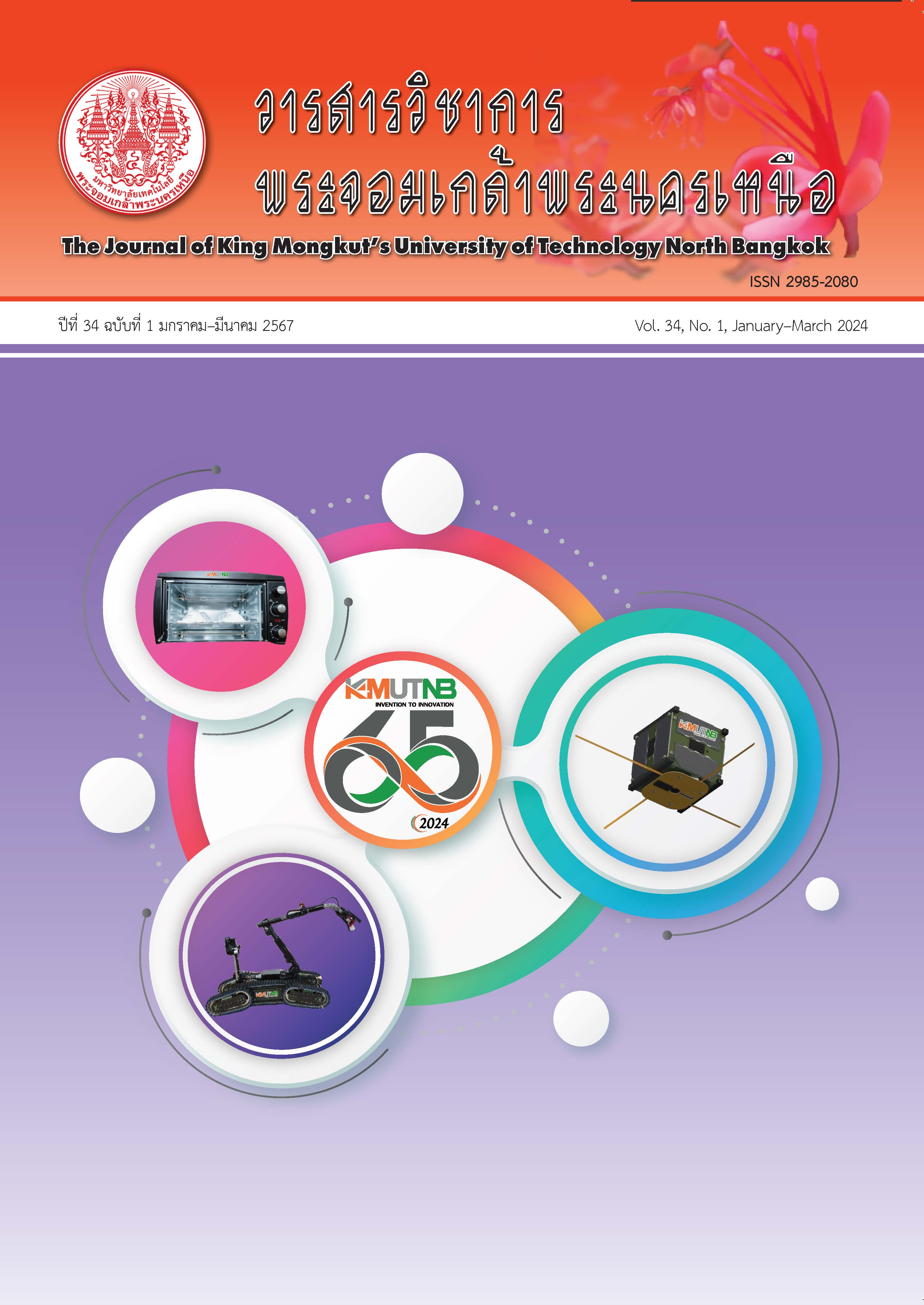การพัฒนาเครื่องอัดแท่งถ่านชีวมวลสำหรับเศษวัสดุเหลือใช้ทางการเกษตรในจังหวัดระยอง
Main Article Content
บทคัดย่อ
การศึกษาอัดแท่งถ่านชีวมวลจากวัสดุเหลือใช้ทางการเกษตรหลายชนิดพบว่าแท่งถ่านยังมีประสิทธิภาพในการใช้งานไม่ดีเท่าที่ควร เนื่องจากมีความเปราะบาง ความชื้นสูงทำให้เกิดเชื้อรา มีความยุ่งยากในการผลิต ระยะเวลาเผาไหม้สั้น และมีควันมาก งานวิจัยนี้จึงต้องการสร้างเครื่องอัดแท่งถ่านชีวมวลและเพื่อหาสัดส่วนของวัตถุดิบที่เหมาะสมในการผลิต โดยใช้ถ่านเปลือกทุเรียนและเปลือกมังคุดผสมในอัตราส่วนที่แตกต่างกันโดยใช้แป้งเปียกเป็นตัวประสาน อัตราส่วนการผสมโดยน้ำหนักระหว่างเปลือกทุเรียนและเปลือกมังคุด คือ 4:1 2:1 3:2 1:1 2:3 1:2 และ 1:4 เครื่องทำถ่านอัดแท่งชีวมวลประเมินจากความสามารถในการขึ้นรูป ลักษณะทางกายภาพ และความหนาแน่นของถ่านอัดแท่ง ขณะที่คุณสมบัติของถ่านอัดแท่งจะทำการวิเคราะห์ตามมาตรฐานของสมาคมการทดสอบและวัสดุแห่งอเมริกา ผลการวิจัยพบว่า เครื่องนี้ใช้งานได้อย่างมีประสิทธิภาพ โดยถ่านอัดแท่งชีวมวลสามารถอัดขึ้นรูปได้ดี ลักษณะผิวเรียบ มีความแข็งแรงไม่แตกหักความหนาแน่นทุกอัตราส่วนผสมอยู่ระหว่าง 604.94 - 612.12 กิโลกรัมต่อลูกบาศก์เมตร ในขณะที่ถ่านอัดแท่งจากเปลือกทุเรียนและเปลือกมังคุดในอัตราส่วน 1:4 มีความเหมาะสมมากที่สุด เนื่องจากมีค่าความร้อนมากที่สุด (5,572.78 กิโลแคลอรีต่อกิโลกรัม) ปริมาณความชื้นน้อยที่สุด (ร้อยละ 4.82) ปริมาณสารระเหยน้อยที่สุด (ร้อยละ 7.26) ปริมาณเถ้าน้อยที่สุด (ร้อยละ 9.47) ค่าคาร์บอนคงตัวมากที่สุด (ร้อยละ 75.39) ทั้งยังมีความหนาแน่น 606.32 กิโลกรัมต่อลูกบาศก์เมตร ประสิทธิภาพการใช้งานร้อยละ 22.79 และมีระยะเวลามอดดับ 99.47 นาที
Article Details

อนุญาตภายใต้เงื่อนไข Creative Commons Attribution-NonCommercial-NoDerivatives 4.0 International License.
บทความที่ลงตีพิมพ์เป็นข้อคิดเห็นของผู้เขียนเท่านั้น
ผู้เขียนจะต้องเป็นผู้รับผิดชอบต่อผลทางกฎหมายใดๆ ที่อาจเกิดขึ้นจากบทความนั้น
เอกสารอ้างอิง
DEDE. (2020, Dec.). Energy Situation January – December 2020. Ministry of Energy, Thailand. [Online]. Available: https://www.dede.go.th/ download/stat63/fontpage_dec2020.pdf
A. Ussawarujkulchai, C. Semsayun, N. Prapakdee, N. Pieamsuwansiri, and N. Chuchat, “Utilization of durian and mangosteen peels as briquette fuel,” in the Proceeding of 49th Kasetsart University Annual Conference: Science, Bangkok, 2011, pp. 162–168 (in Thai).
K. Boonchom and N. Chaisompan, “Study of charcoal briquette from longan wood,” Naresuan Phayao Journal, vol. 13, no. 2, pp. 51–56, 2020 (in Thai).
K. Sukaranandana and N. Tanpaiboonkul, “Utilization of cassava residue from agro- Industry as binder with powder of Palmyra palm fruit peel charcoal for briquettes fuel production,” Veridian E-Journal, vol. 6, no. 5, pp. 48–65, 2019 (in Thai).
V. Yubolket and D. Settheetham, “Quality Comparison of leaf-trash chunk-compressed fuel by compressor and hand,” KKU Research Journal (Graduate Studies), vol. 17, no. 4, pp. 85–96, 2017 (in Thai).
Thai Industrial Standards Institute (TISI), Community Products Standard No. 238, 2004.
A. Kitipattaworn, P. Reubroycharoen, and W. Uttamaprakorn, “Briquette fuel from co-production of ethanol industrial wet cake and biomass,” Journal of Energy Research, vol. 10, no. 3, pp. 43–56, 2013.
S. Mongkolchaichana and P. Wongkhankaew, “Development of a biomass briquetting machine from rice straw,” in GNRU Proceeding, Phitsanulok, 2017, pp. 2307–2317.
P. Yooman, “Development of a cold production biomass charcoal briquette machine to use waste from coffee bean processing,” I-Tech Journal LPRU, vol. 9, no. 1, pp. 34–48, 2016 (in Thai)
S. Ramanchit, “Design and development of charcoal screw-press briquette machine with automatic cutting,” I-Tech Journal TRU, vol. 14, no. 2, pp. 9–13, 2019 (in Thai)
K. Namwong and M. Kanaphan, “Design and development of a briquette machine for briquettes production from dried neem leaves and burned sawdust,” in ME-NETT, Nakorn Nayok, 2017, pp. AEC 06.
J. Arévaloa, G. Quispea, and C. Raymundob, “Sustainable energy model for the production of biomass briquettes based on rice husk in low-income agricultural areas in Peru,” Energy Procedia, vol. 141, pp. 138–145, 2017.
L. Wattanachira, N. Laapan, V. Chatchavarn, and A. Thanyacharoen, “Development of biobriquettes from mixed rice-straw and longan waste residues,” KMUTT R&D Journal, vol. 39, no. 2, pp. 239–255, 2016. (in Thai).
ASTM International Standard Test Method for Moisture in the Analysis Sample of Coal and Coke, ASTM Standard D3173, 2017.
ASTM International Standard Test Method for Volatile Matter in the Analysis Sample of Coal and Coke, ASTM Standard D3175, 2020.
ASTM International Standard Test Method for Ash in the Analysis Sample of Coal and Coke from Coal, ASTM Standard D3174, 2020.
ASTM International Standard Practice for Proximate Analysis of Coal and Coke, ASTM Standard D3172, 2021.
ASTM International Standard Test Method for Gross Calorific Value of Coal and Coke, ASTM Standard D5865, 2019.
K. Chaiwong, N. Vicharn, A. Saenthaweesuk, C. Thawonngamyingsakul, and T. Janhom, “Effect of inlet air flow on thermal efficiency of bio-char stove from agricultural waste,” RMUTL Engineering Journal, vol. 1, no. 1, pp. 37–42, 2016 (in Thai).
D. Dangphonthong and W. Pinate, “The promotion of production charcoal briquette from agricultural residues for use in the community household under the philosophy of sufficiency economy,” Mahasarakham University, Mahasarakham, Rep, 2014 (in Thai).
L. Ifa, S. Yani, N. Nurjannah, D. Darnengsih, A. Rusnaenah, M. Mel, M. Mahfud and H. S. Kusuma, “Techno-economic analysis of bio-briquette from cashew nut shell waste,” Heliyon, vol. 6, no. 9, 2020.
S. Sawekwiharee, “Potential energy of the fuel briquettes from mangosteen shell,” Rajamangala University of Technology Phra Nakhon, Bangkok, Rep. 2012 (in Thai).
T. Chaichana, J. Waewsak, J. Kaew-On and U. Onthong , “Fuel properties of mangosteen pericarp charcoal,” Thaksin University Journal, vol. 17, no. 3, pp. S29–36, 2014 (in Thai).
DAE. (2020, Dec.). Economic Plants Database in Rayong, 2019–2020. Ministry of Agriculture and Cooperatives, Thailand. [Online]. (in Thai). Available: http://www.rayong.doae.go.th/ eco%20province%2063.pdf

